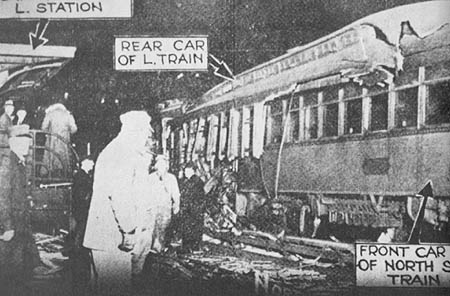

![]()
The practice of mixing trains of the Chicago elevateds and the North Shore Line interurban on the same right-of-way was the source of more than one accident on the "L". But the incident that occurred at the Granville station in 1936 was, for many decades, the worst accident to occur on the Chicago rapid transit system.
Between Wilson and Howard, the North Side "L" is a four track operation, with the outside tracks providing express service and local trains using the inside tracks. The stopping patterns have varied greatly over the years, however; there is a crossover north of the Granville station and some express trains (the Loyola Express, among others) used to run express northbound to this point, then switch to the inside tracks to stop at Loyola and Morse before reaching Howard. (Southbound trains did the opposite.) North Shore Line trains made relatively few stops on the "L", and used the outside tracks all the way to Howard to bypass the slower "L" locals.
During rush hours, trains operated on very close headways, sometimes only a couple thousand feet apart. There were no automatic block signals in those days, just on-sight operation. At one point in the evening schedule, a North Shore Line Mundelein Express followed an "L" Loyola Express north out of Wilson station. Both trains used the northbound outside track (track 4) and remained fairly close together. About the same time, a local train was scheduled to be proceeding north, meeting the other two trains near Granville. It was customary for the towerman at Granville station to set the signal against the local on the inside track (track 3), keeping it in the station. The Loyola Express would then cut in front of it, switching from track 4 to track 3, allowing the faster express to precede the slower local train. The switches would then be realigned, the North Shore would be given the green board to proceed on track 4, with the local on track 3 then released for departure. The motorman on the three-car North Shore train was familiar with this routine and usually hung close to the Loyola Express, often slowing to no less than 30mph during the whole operation.
 The wooden rear coach of the "L" train was completely telescoped by steel North Shore car 721. Yes, that is the roof and side walls of the "L" car wrapped around the interurban car. Granville station is on the left. For a larger view, click here. (Photo from the Chicago Tribune) |
Nine "L" passengers died immediately in the accident; a tenth passed away the following day from injuries sustained. Many were taken to area hospitals, 36 with serious injuries.
Investigators officially placed the blame on Van Grooms, the North Shore motorman, for following the "L" train too closely and failing to stop in time. The accident brought to light, however, several questionable practices that existed on the "L" at that time. The investigators recommended that the Chicago Rapid Transit Company install automatic block signals on their tracks so that trains could be spaced out properly. (No automatic signaling system was placed on this part of the "L" for another forty years however, resulting in another serious "L"/North Shore accident at Wilson station in 1956.) They also recommended that they stop mixing wooden and steel cars in their trains, a practice long since discontinued on main line railroads. They also recommended they phase the wooden cars out completely as soon as possible, something not achieved until 1957.
Sources:
Campbell, George V., North Shore Line Memories, Northbrook, IL: Domus Books, 1980.
Young, David M. Chicago Transit: An Illustrated History, DeKalb, IL: Northern Illinois University Press, 1998.